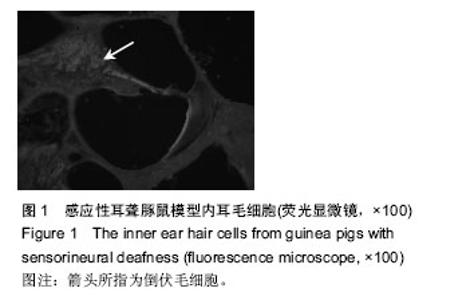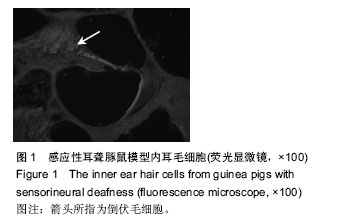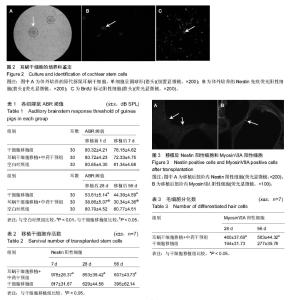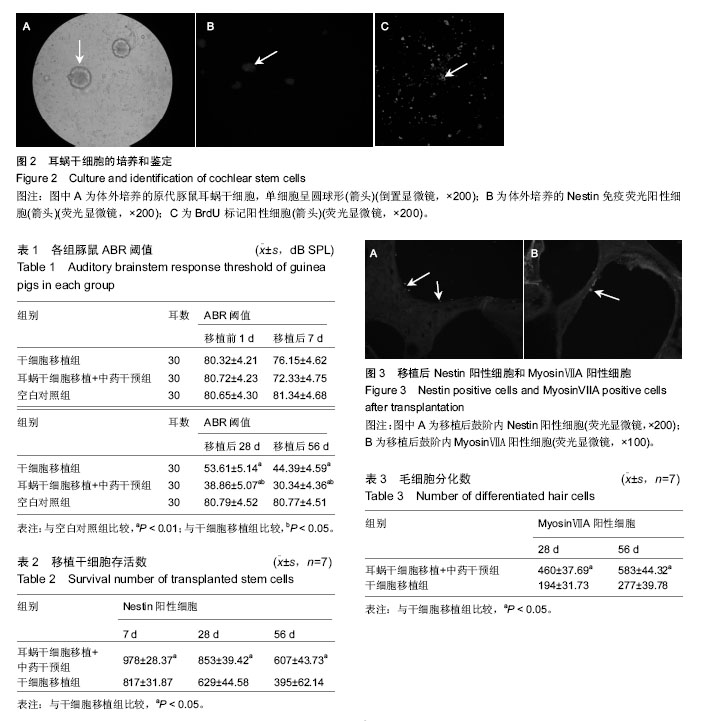| [1] Tao L, Segil N. Early transcriptional response to aminoglycoside antibiotic suggests alternate pathways leading to apoptosis in sensory hair cells in the mouse inner ear. Front Cell Neurosci. 2015;9:190.
[2] Kuo BR, Baldwin EM, Layman WS, et al. In Vivo Cochlear Hair Cell Generation and Survival by Coactivation of β-Catenin and Atoh1. J Neurosci. 2015;35(30):10786-10798.
[3] Zhang W, Zhang F, Han Y, et al. Auditory stimulation modulates CXCL12/CXCR4 expression in postnatal development of the newborn rat cochlea. Neuroreport. 2015;26(12):681-687.
[4] Costa A, Sanchez-Guardado L, Juniat S, et al. Generation of sensory hair cells by genetic programming with a combination of transcription factors. Development. 2015;142(11):1948-1959.
[5] Ohnishi H, Skerleva D, Kitajiri S, et al. Limited hair cell induction from human induced pluripotent stem cells using a simple stepwise method. Neurosci Lett. 2015; 599:49-54.
[6] Jang S, Cho HH, Kim SH, et al. Neural-induced human mesenchymal stem cells promote cochlear cell regeneration in deaf Guinea pigs. Clin Exp Otorhinolaryngol. 2015;8(2):83-91.
[7] 郑鸿燕,邰浩清,周春祥.耳蜗前体细胞体外培养和诱导分化的实验研究[J].复旦学报:医学版,2006,33(5):601-605.
[8] 郑鸿燕,邰浩清,曾水林.耳蜗提取液诱导海马神经干细胞分化的实验研究[J].神经解剖学杂志,2006,22(5):542- 546.
[9] 郑鸿燕,邰浩清,曾水林.当归补血汤对感音神经性聋大鼠耳蜗干细胞移植后细胞凋亡的影响[J].听力及言语疾病杂志,2010,18(3):271-274.
[10] Zheng HY, Tai HQ, Zeng SL. Cochlear stem cell transplantation for hearing recovery in a rat model of sensorineural hearing loss. Neural Regen Res. 2010; 5(11):833-837.
[11] 吴岩,祝彼得. 当归补血汤对内皮细胞增殖和粘附分子表达的影响[J].华西医科大学学报, 2001, 32(4):593-595.
[12] 王斌,李杰芬,胡岳山.当归多糖对小鼠脾脏树突状细胞增殖的影响[J].解剖学杂志,2005,28(4):403-404.
[13] 张英华,武桂兰,姜廷良. 当归补血汤及其组成药味的含药血清对造血祖细胞(CFU-GM)的影响[J].中药药理与临床, 1998,14(4):3-5.
[14] 郑鸿燕,邰浩清,曾水林. 当归补血汤含药血清体外诱导耳蜗干细胞的增殖分化[J].解剖学杂志,2006,29(6):682- 685.
[15] 郑鸿燕,邰浩清,曾水林. 当归补血汤对耳蜗干细胞鼓阶内移植治疗药物性感音神经性耳聋大鼠增效作用研究[J].东南大学学报:医学版,2010,29(2):176-182.
[16] Bermingham NA, Hassan BA, Price SD, et al. Math1: an essential gene for the generation of inner ear hair cells. Science. 1999;284(5421):1837-1841.
[17] Zheng JL, Gao WQ. Overexpression of Math1 induces robust production of extra hair cells in postnatal rat inner ears. Nat Neurosci. 2000;3(6):580-586.
[18] Zheng JL, Shou J, Guillemot F, et al. Hes1 is a negative regulator of inner ear hair cell differentiation. Development. 2000;127(21):4551-4560.
[19] Chen P, Johnson JE, Zoghbi HY, et al. The role of Math1 in inner ear development: Uncoupling the establishment of the sensory primordium from hair cell fate determination. Development. 2002;129(10): 2495-2505.
[20] Kawamoto K, Ishimoto S, Minoda R, et al. Math1 gene transfer generates new cochlear hair cells in mature guinea pigs in vivo. J Neurosci. 2003;23(11): 4395-4400.
[21] 范为民,李艳,胡怡芳.浅议“耳肾相关论”[J].辽宁中医杂志,2014,41(10):2078-2079.
[22] 胡晓阳,张双良,朴圣爱,等.段富津教授治疗耳鸣验案举隅及浅析[J].中医药信息,2015,32(3):54-55.
[23] 于川.浅析缪刺泄络通窍法治疗耳鸣[J].中国中医药现代远程教育,2014,12(3):125-126.
[24] 陈水星.六味地黄丸治疗肝肾阴虚内科杂病[J].实用中医内科杂志,2014,28(11):124-126.
[25] 李霞,马家骅,李楠,等.当归补血汤相状态的研究[J].中国实验方剂学杂志,2011,17(2):1-5.
[26] 戴冰,肖子曾,冷旺,等.不同剂型六味地黄方含药血清对大鼠前脂肪细胞增殖与分化的影响[J].中药材,2006,32(2): 270-272.
[27] 舒谦,卿茂盛,曹亚飞.六味地黄汤含药血清对软骨细胞增殖、凋亡影响的体外实验研究[J].中国中医药科技杂志, 2006,13(4):217-219.
[28] 刘继平,兰洲,傅强.六味地黄汤相关苷类单体对小鼠脾淋巴细胞增殖作用的研究[J].中医药信息杂志,2011,28(5): 49-52.
[29] 赵丽艳,薄云,赵青山.六味地黄汤加减对脑血流量及血液流变性的影响[J].中国实验方剂学杂志,2012,18(3):222- 223.
[30] 丘婷,李天河,吴思.六味地黄汤生物制剂对小鼠耐寒、耐缺氧及抗疲劳作用的实验研究[J].广东药学院学报,2011, 27(6):621-623. |



